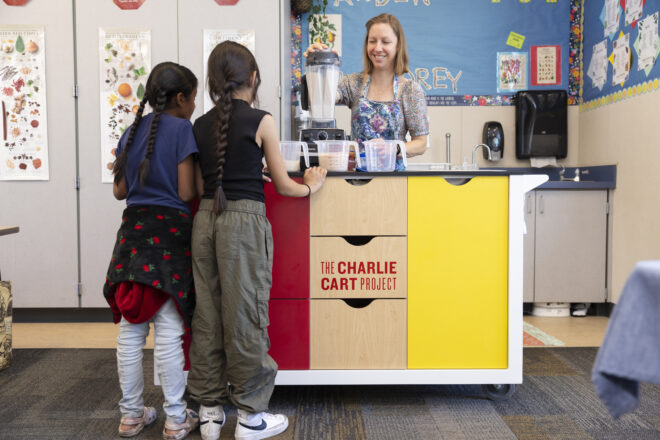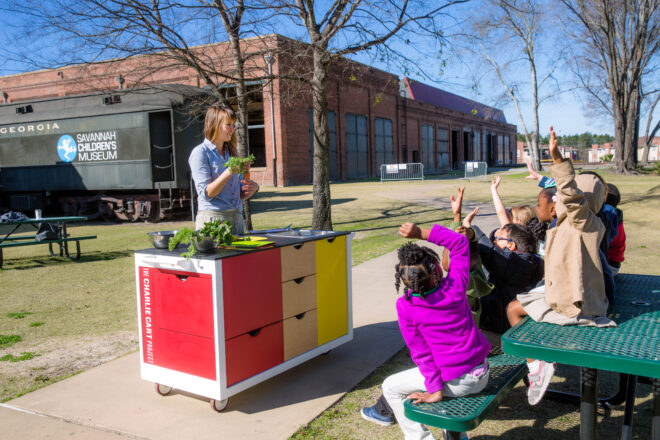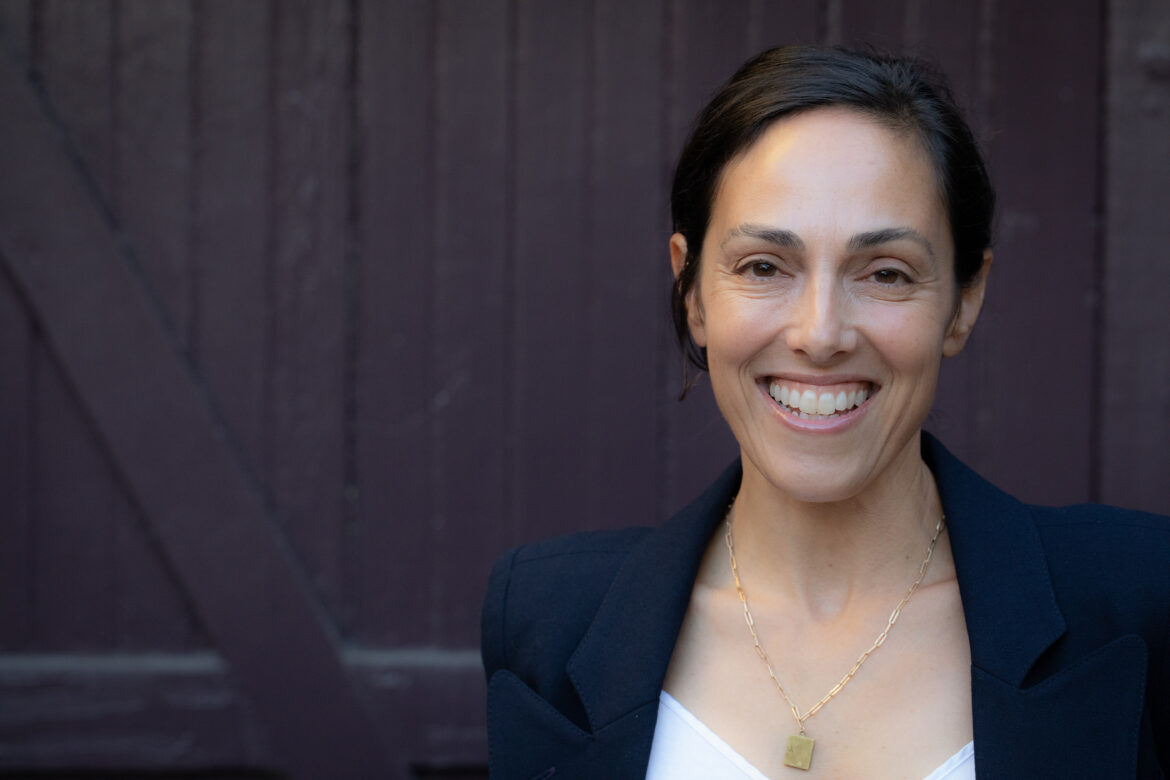The Charlie Cart Project is a national nonprofit dedicated to hands-on food education for kids, bringing fully equipped mobile kitchens into schools, libraries, clinics, and community centers across 47 states. With a Common Core–aligned curriculum and an eye-catching cart packed with professional-grade tools, the program helps over half a million children and families each year build practical cooking skills and a deeper understanding of the connections between food, health, and the environment. In this interview, we speak with founder and executive director Carolyn Federman, an author and longtime food education advocate, about the project’s origins, its impact, and what’s next.
Let’s start at the beginning: what sparked the initial idea for The Charlie Cart Project? What made you believe the idea was scalable and worth pursuing as a national project?
I was working with Alice Waters and the Edible Schoolyard Project, and I saw how transformative hands-on cooking was for kids–they just opened up, tried new things, and seemed to blossom right there in front of me. But I also heard from many educators that the model – a fully built-out teaching kitchen and garden – was out of reach for their communities. I was inspired by their desire to make it happen anywaysSo I set out to create a way to bring food education to every child–something hands-on, affordable, and adaptable.
How is it that we teach kids to learn math so they can balance their checkbooks, and to read so they can follow signs and instructions, and yet we don’t teach them about food, which sustains them, fuels learning, and profoundly impacts their health and the health of the planet?
From the start, I designed Charlie Cart to be scalable. I grew up in Silicon Valley, after all. It’s a turnkey platform: a fully-stocked, mobile kitchen on wheels with curriculum and training, priced accessibly so that schools, libraries, food banks, and community centers can quickly and easily launch cooking programs for their communities.
You’ve worked with some major food education pioneers: Alice Waters, Michael Pollan, Jamie Oliver. What did you take from those experiences that shaped how you approached founding TCCP?
From Alice I learned to be uncompromising, and to see beauty as a language of care. Charlie Cart wouldn’t exist without her ingenuity and commitment to teaching kids about fresh, delicious, unprocessed food. Many of our curriculum’s 54 seasonal recipes–developed by former Chez Panisse chefs–grew directly out of my time at Edible Schoolyard, as did our hands-on classroom approach.
From Michael I got an ad-hoc PhD in food systems! Through our work on the Edible Education course at UC Berkeley, I learned how vast and interconnected the food system is—the “big, lumpy tent” as Michael called it—from farm workers’ rights to regenerative practices to lab-grown foods. This lens helped shape the framework for the Charlie Cart curriculum: what do we want kids to understand about where their food comes from and the giant ecosystem it is part of?
From Jamie I learned the importance of both relationship building and public engagement. His work made clear that without parents and administrators on board, school food programs can’t succeed. That’s why, at Charlie Cart, we invest in sharing tips, stories, and impact data from and with our educators, so that we can demonstrate how powerful food education really is.
The Charlie Cart itself is such a tactile, beautiful object: part tool, part symbol. Can you talk for a moment about why the physical design is so central to your vision?
Thank you! That’s due to Brian Doherty of Celery Design. I came to him with an unusual ask: to build a beautiful kitchen on wheels for schools. I’d learned that schools had to go through a bidding process for anything over a certain price, so they often ended up with the cheapest option, even if it wasn’t what they really needed.
That seemed like a backward notion. Kids are our precious, and only, future–they deserve the best. I asked Brian to design something beautiful and irresistible; something that would draw kids in and make them feel valued, cared for, important, and trusted. He understood exactly what I meant, and he nailed it.
One teacher in a small rural town told us, “It’s amazing to see the kids huddled around this beautiful piece of equipment, so excited and knowing it’s theirs. They have never had anything like this.” That’s the power of thoughtful design.

One of your goals is to make food education “scalable, accessible, and engaging.” What are the biggest logistical or systemic barriers you’ve faced in making hands-on cooking education more common?
First, there’s a general misconception about what food education is–and why it matters. Food education is foundational to children’s development, lifelong health, and food security. Our first job is to make that case.
Scalability isn’t just about blanketing the country with mobile kitchens; it’s about making sure they’re in use and having a positive impact. To ensure this, we support our educator network with resources and community, and by collecting and sharing stories from both educators and students. Incorporating feedback has always been a critical part of our model, and in the coming years evaluation will be front and center as we focus more deeply on measuring our impact on the ground.
You’ve said that empowering kids with culinary literacy helps build confidence, not just health-wise but emotionally and intellectually. Can you share a moment or story from the field that captures this?
In rural Alaska we made smoothies with K-8 students, many of whom had never seen or used a blender. As each child came to the cart to try the machine, the room came alive. They were transformed from shy and disengaged to laughing and shouting at the top of their lungs to be heard above the sound of the Vitamix. They came completely out of their shells! That transformation was incredible to witness.
Another favorite moment was shared by a teacher using the Charlie Cart in South Carolina: “Guacamole is my favorite Charlie Cart recipe! Kids get to explore fresh ingredients through a sensory-rich experience. They mash avocados and squeeze limes with huge smiles. For some it’s a cultural bridge. one student suggested a tweak to the recipe, based on his family’s version: ’My mom makes that! You should add onions!’ For others, Guacamole- -and so many other recipes–offerS a way to connect with family across generations. That kind of engagement goes beyond nutrition; It can serve as a glimpse into a new culture or reflect and validate their own experiences. And for just about everyone, it creates a shared moment while building confidence and pride.”
TCCP has grown to reach more than 500,000 kids annually across 47 states. How do you maintain quality and consistency across such a large network?
The curriculum was designed to center educators. We believe they know their students best, so our materials offer structure and support but are flexible by design. Some teachers follow every lesson to the letter. Others pick and choose what they need. We meet people where they are and walk alongside them. Many educators are learning right along with the students, and we are absolutely here to support them!
It does happen that some programs will pause or even go dormant due to lack of funding or turnover. That’s real. We believe the best way to support sustainable programs is to create community amongst our practitioners and share their successes as widely as possible.
With the new podcast and educator profiles, you’re elevating the voices of people using food to heal and build power. How does storytelling play a part in your mission?
Stories change minds more than facts do. They are more relatable, for one thing, and they stick more easily in people’s minds. Food education touches on a lot of issues, and stats don’t always get to the heart of demonstrating impact in the way a potent story does.
To make food education universal, we need buy-in from across the community. That means convincing a wide range of stakeholders that this work matters, and that it makes a difference. Storytelling is one of the most powerful ways we can do that.
We’re seeing renewed national interest in food literacy and food as medicine policies—but implementation often lags. What policy changes or investments would help programs like yours thrive?
Food education must be integrated into food assistance and school meal programs. Food education is a critical component of food access. Children won’t choose nourishing fresh food if it’s unfamiliar, and parents won’t choose it if they don’t know how to prepare it. If we want to change the health trajectory of this country, including decreasing food insecurity, we have to get on board with this reality. Most funders, individual and institutional, have not yet recognized this; they still see food education as a luxury when in actuality, it’s a lifeline.
Investment in food assistance programs, support for the EPA, regulation of corporate marketing to kids, support for local food to schools and community organizations, and support for nutrition education across and in combination with all food assistance programming–any and all of these help.
What we’re solving for is bigger than what we can accomplish on our own, so at Charlie Cart we want to collaborate with organizations working on issues across the system, from public transportation (to make sure everyone can get to a grocery store, for example) to procuring fresh, local produce for schools. The cuts to federal food programs will make our collective work more challenging, so we have to double down on efforts to support those people making change in their own communities.

The Charlie Cart is coming up on its 10th anniversary. Looking ahead, what’s your vision for the next 10 years of the project, and for the future of food education in the U.S.?
We were part of the White House Commitment to End Childhood Hunger in 2023, and I was fortunate to hear José Andrés describe his vision for the food system: “We need a food President!” I feel the same! Food connects everything from health to economy to climate change, so we all need to be informed about food. Food education MUST be part of the conversation, full stop.
We can do this by making food education available to everyone, and that starts with trusted community-based organizations like libraries, schools, and clinics.
The Charlie Cart Project continues to push for food education for all by advocating at the local and federal level, providing tools and training to empower agents of change in their communities and facilitating partnerships across those communities to amplify efforts and bring life-changing cooking skills to children everywhere.
Fast Facts:
Where did you grow up? Saratoga, California, but my parents were born and bred in New York, so I feel a major affinity.
What city or town do you call home? Berkeley, CA. I love it 🙂
What is your background and education? I grew up in California with 2nd generation immigrant parents (New York via Eastern Europe). Food was central to our family culture, and we were so fortunate to be exposed to all types of food, thanks to the great diversity of people in this state. We are a family of big eaters, and relished all of it, from Chinese Dim Sum where we’d eat everything on the menu to all that amazing Mexican food we have in California. My mom cooked everything, but her roots were Eastern European so things like beef tongue made a regular appearance. She cooked the dishes of her time, like skillet burgers smothered in Campbell’s cream of mushroom soup(!), but she was also a devotee of Sunset magazine and The New York Times Cookbook, where she learned to make the world’s best chocolate mousse and a killer lasagne. Later, I studied socio-cultural anthropology at UC Berkeley and had an opportunity to put all that delicious food into historical context.
What is one word you would use to describe our food system? Mired.
Who is your food policy hero? Representative Jim McGovern, Marion Nestle, and José Andrés.
What was your breakfast this morning? Chilaquiles.
What is your favorite food? Anchovies. And lemons.
What would be your favorite last meal on earth? Salad, with really crisp lettuce or chicories, and a very vinegary dressing of anchovies, lemon, capers, and macerated shallots. And a few delicious things added in for texture, like cheese, dates, and almonds. I would want to experience a lot of crunch if it was my last meal!
What is your favorite food hangout? My kitchen, when my friends and family are there with me.
Who are your food policy social media must-follows? FRAC, FoodFix, Marion Nestle, CSPI, Farm to School National, Civil Eats, FoodCorps, No Kid Hungry


